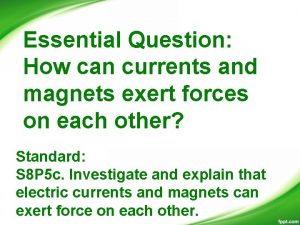Magnets and Forces Tasc To explain how magnets

- Slides: 1

Magnets and Forces Tasc: To explain how magnets have been used to help navigation. Pupils should be taught to: • compare how things move on different surfaces • notice that some forces need contact between two objects, but magnetic forces can act at a distance • observe how magnets attract or repel each other and attract some materials and not others • compare and group together a variety of everyday materials on the basis of whether they are attracted to a magnet, and identify some magnetic materials • describe magnets as having two poles • predict whether two magnets will attract or repel each other, depending on which poles are facing. Additional Information: • Create patterns with iron filings. • Magnetic and non-magnetic materials. • Different poles. Music: • Strength of magnets Scheme: Follow Manchester • Create a compass Controlling voice/instruments- dynamics/ • Magnetic tempo Fields around the Earth/Aurora Reading / writing notation – crotchets, crochets breaks, quavers. Phrasing – ostinato / drone Explore Viking Music – which instruments did they use. How did they make them? Computing E-Safety – Tasc: To create a database, collating facts about Norse culture, • Create, search and manipulate a database. • Order information • Discuss the benefits of storing information in an organised manner. RE: Art / DT Special People Tasc – To design and make a Viking Longboat Pupils should be taught: Design • use research and develop design criteria to inform the design of innovative, functional, appealing products that are fit for purpose, aimed at particular individuals or groups • generate, develop, model and communicate their ideas through discussion, annotated sketches, cross-sectional and exploded diagrams, prototypes, pattern pieces and computeraided design Make • select from and use a wider range of tools and equipment to perform practical tasks [for example, cutting, shaping, joining and finishing], accurately • select from and use a wider range of materials and components, including construction materials. Evaluate • evaluate their ideas and products against their own design criteria and consider the views of others to improve their work • understand how key events and individuals in design and technology have helped shape the world Moses – Who was he? Why is he so important to the religion of Judaism. Literacy Following Primary Framework and linking with the Vikings through: • Myths – Writing stories based on Norse Mythology. • Instructions – How to build a Viking Longboat. The Vikings Spring term PSHE/SEAL Year 3 Numeracy: Following Primary Framework and linking with the Stone Age: B 2 – Number facts and shape Going for Goals History • Target setting Tasc: To perform a play about the lives of Edward the Confessor and Ethelred the Unready. • Aspirations Pupils should learn about the Viking and Anglo-Saxon struggle for the Kingdom of England to the time of Edward the Confessor C 2 – Data Handling Additional Information: Additional Information • Lives of Edward/Godwine/Ethelred and Harold. Viking coordinates – plotting routes around Europe • Attack of Lindisfarne • Norse Mythology • Everyday life as a Viking • Viking Houses • Viking Longboats • Trade routes • Viking Women – Sigrid the Haughty - Valkyries Outdoor Games: Tasc: To create an invasion game based on the Viking Invasion of Britain. Dance: Tasc: To create a dance with a partner, considering meeting and parting, emphasising the use of space. Gym Tasc: To develop jumps and balances by putting weight on the hands.

